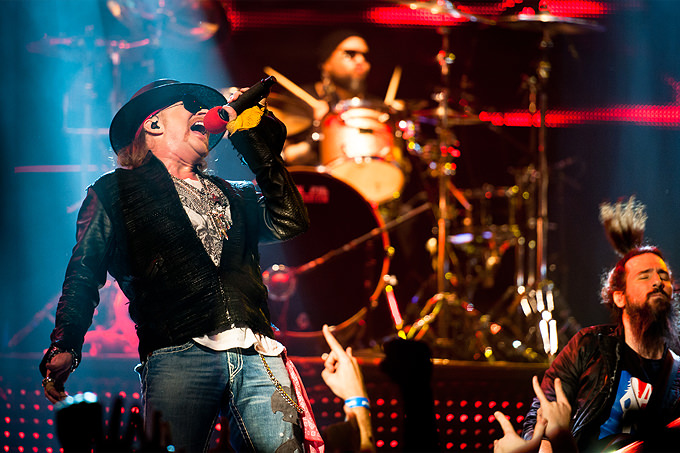
How to Shoot Concert Photography Part 1
So, you wanna shoot a rock show? Of course you do. It sounds awesome, right? Getting the up close and intimate shots of artists as they rock out literally inches away from you. Getting into the show for free. Meeting the bands and photographing their portrait. Late nights and loud music—I was born for this party. If this is your idea of what photographing live shows is like, you’ve got another thing coming.
What’s up, Phlearn phamily? My name is Brendan Shanley and I’m a semi-professional photographer living in Chicago. Recently, the team at Lost In Concert—a Web-based music publication—launched a Kickstarter campaign to produce an epic 160-page book featuring amazing concert photography and artist interviews. Now I’m teaming up with Phlearn to create this article to shed some light on the world of concert photography.

In order from left to right, top to bottom: Delta Spirit at Lollapalooza, Yeasayer at the Vic Theatre, Steel Panther at The House of Blues Chicago, 311 at Charter One Pavilion, Local Natives at Metro, Band of Skulls at Metro
For years I’ve been enjoying Chicago’s lush music scene. One thing that’s always annoyed me is the strict camera policies for the concert goers. 3 years ago I started Lost In Concert with the mission to help people live and relive concert moments through better photography.
Today, Lost In Concert is a group of volunteer photographers and writers who all share a similar love for the live music experience. It’s a love for sharing and a love for live music that keeps us creating new content regularly—despite other jobs and commitments. The most common reply I hear when I tell someone I shoot live music is, “Oh man! That’s great, huh? I love going to shows.” I laugh a little every time because I completely understand this point of view. Hell, I used to think the exact same way. And while it is certainly still fun, for me and those like me, the concert experience is completely different.
Where does the process begin?
To shoot shows you typically have to shoot for a publication of some sort in order to be granted photo credentials for a show. If you aren’t affiliated with a media outlet I’d suggest emailing your portfolio to the outlets whose work you admire and aspire to be like the most. Some photographers may also build a reputation for themselves as concert photographers and can gain credentials on behalf of the band. If you want to start down this rabbit hole but can’t find a media outlet that will work with you try finding out which venues in your area don’t have strict camera policies.
Every city has some place like this. Start building your portfolio by shooting at these venues and by trying to meet local bands and getting them to have you shoot their shows. You’d be surprised what you can get if you just ask for it. I’ll walk you through some important points you should know about before you answer the initial question: So, you wanna shoot a rock show?
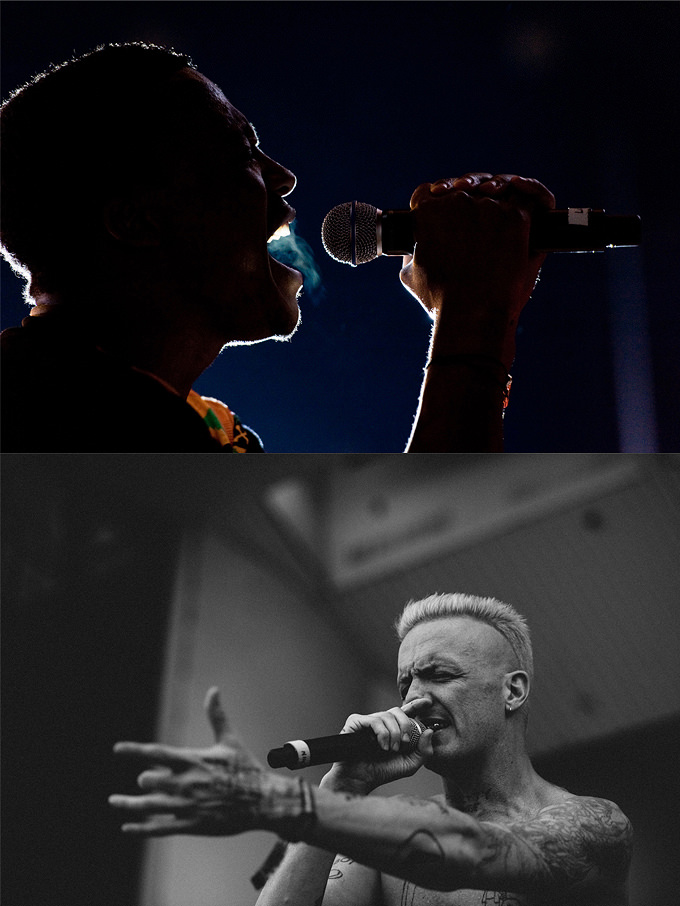
Lupe Fiasco at North Coast Music Fest, Die Antwoord at Lollapalooza
For me it all starts a few months before the show. I’ll receive an email from a band’s PR or management company explaining that they are coming to town soon. This email falls somewhere amongst the other dozens of messages about another band’s new video, EP announcement, label signing, member change, or whatever other message the industry considers newsworthy.
Sorting through the email aspect of this alone takes hours. You will need to decide which shows you want to feature live coverage for and reply accordingly. Or compose a new email message to the band you want to shoot outlining your proposal of coverage. Now that your proposal email has been sent it’s time to play the waiting game. IF you hear back their might be a request for you to help promote the show with a preview of some sort.
Often times, you may not hear back with a confirmation until a day or two prior. This is a large departure from my days as a fan where I’d wait in line at the Ticketmaster booth and get hard tickets the moment a show went on sale.

Andrew Bird at The 4th Presbyterian Church, Against Me! at The Aragon Ballroom, Thom Yorke w/ Atoms For Peace at The Aragon Ballroom
So now you’ve heard back from the agency handling the media credentials for the show. This email is probably not from the band, the venue or anyone who will actually be at the show. I would recommend always having an on-site contact name and phone number if you can.
I’ll explain why in a bit. Right now, we’ve got to start preparing for the show. After all we have less than 24 hours before the doors open. Before packing your gear bag for a show you’ll want to know the answers to a few questions:
– Will I be shooting a portrait of the band before or after their set?
– Will there be a photo pit? Where in the venue can I shoot from?
– How long will I be able to shoot for?
– What if I arrive and I’m not on the band’s list?
In taking a closer look at each of these questions we’ll be able to reveal a lot about shooting a show.
Will I be shooting a portrait of the band before or after their set?
I start with this question because this alone dictates whether or not I’m going to pack a speedlight. 99% of venues you will shoot at do not permit the use of flash during the Performance. You don’t want to be ‘that guy’ in the pit. Firstly because the security will likely throw you out if they see you shooting with flash during the Performance. Secondly because it’s really annoying for the band and the other photographers in the pit. Yes, I have caught someone’s flash from the crowd more than once in my photos. They don’t know any better in the crowd though.
Still, I wish the audience would put down their cameras and start dancing, partying or rocking out more. Along the same lines as flash photography, if your camera has a focus Light setting for auto-focussing you should be sure that’s set to off. It’s a total faux pas.
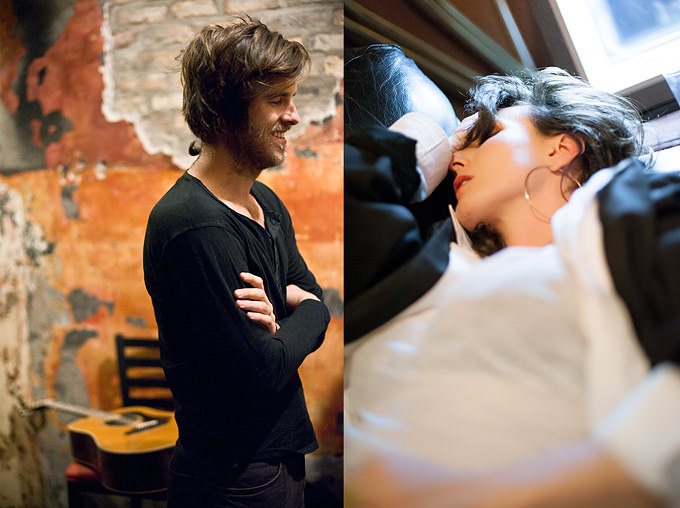
Graham Colton backstage at Lincoln Hall, Class Actress backstage at Lincoln Hall
If I have arranged to shoot a portrait of the band I’ll pack my Nikon SB-900 speedlight. Speedlights are great for traveling light weight. I may also bring a small Light stand and/or a shoot through umbrella if I think I’ll have the space for it. If you don’t want to carry the stand, having someone else simply hold the Light works just as good. If you can, try to keep the speedlight off the body of your camera.
Adding your light from one side or the other will greatly improve the interest of your image. It can also help to accent or build upon a light source that’s already there. If you’re keeping the speedlight attached to your camera’s hot shoe try to diffuse or bounce the light. When shooting with the speedlight off body, I use Cybersync transmitters and receivers by Paul C. Buff to wirelessly trigger it. They are a great, more affordable alternative to the ever popular Pocket Wizards.
Keep in mind when shooting a portrait of an artist that you may only have a very short period of time. Sometimes under 1 minute. If you’re shooting in a venue’s green room / dressing room the space could be very tight and the decor may be really old and worn. This is definitely not always glamorous. Sometimes you will get lucky and not only have a more sizable amount of time with the band, but you’ll be able to leave the venue and take some outdoor shots.
You could also bring the band to a nearby establishment you enjoy. Do your research of the area you’ll be in so that when this opportunity arises you can act on it properly and with confidence.

Art vs Science – Portraits shot outside near Lincoln Hall
When bringing any equipment that’s battery powered it’s a best practice to bring backup batteries. Yes, this goes for your camera bodies as well. While you probably won’t be shooting long enough to go through even 25% of your speedlight batteries, I’ve seen batteries lose their charge at rest and this can really put a damper on your shooting. Don’t forget about the batteries inside your wireless transmitter and receiver.
Will there be a photo pit? Where in the venue can I shoot from?
For those who are totally new to this term or concept, the photo pit is the area at the front of the venue in between the barricade and the stage. The photo pit is reserved for those on assignment with proper media / photo credentials. Sometimes there will only be about 2 to 3 feet of space running the length of the stage.
Other times there might be 15 feet or more depending on the venue. But just because the venue has a photo pit when you were there the first time doesn’t mean it will be there next time. Often times this will be at the band’s request and you’ll have little prior knowledge if there’s going to be one.
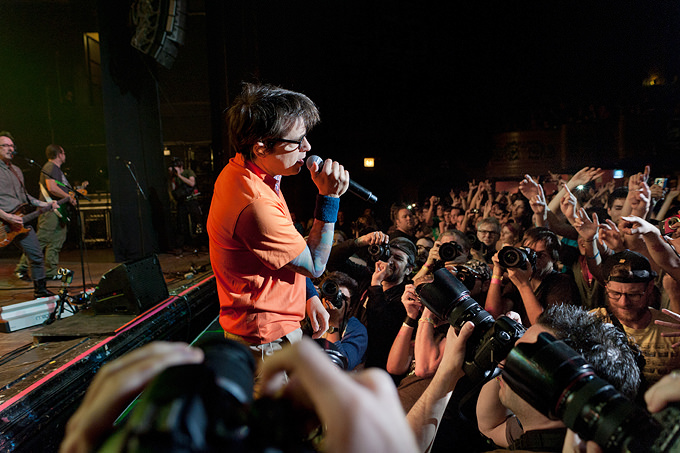
Weezer at The Congress Theater – Fully loaded photo pit
What’s some basic etiquette of the photo pit? Remember you are sharing this space with the other photographers. Be polite, look before you leap and have fun. When I step into a pit I always will say hey or introduce myself to the other photographers if I haven’t met them before. After 3 years it’s really fun to walk into a pit and be on a friendly level with some of the other photographers. In showing respect for others you’ll undoubtedly receive it back. Unless you’re shooting with an iPad or a point and shoot. Then you shouldn’t have been allowed in.
Apologies if you fall under this profile but come on, really?
Be mindful that when shooting in a pit there are certain dangers that present themselves rather unexpectedly. If you’re shooting a louder, faster, more upbeat band, you can pretty much bet that there will be some crowd surfing going on. Generally people who are crowd surfing wind up in the front of the venue and will inevitably be pulled over the barricade into the photo pit by a security guard. If the guard can’t get there in time then the crowd surfer runs the risk of being launched into the pit.
This is also where you run the risk of being kicked in the head or having your gear kicked or stepped on. When you bring gear into a pit, try to find someplace safe to stow it where other photographers, out of control fans and security guards won’t step on it. Heck, find a place where you’re not going to step on it. I usually look for a place near one far end of the pit so if I choose to change lenses I can go to my bag and do it there without being in the way of someone else.
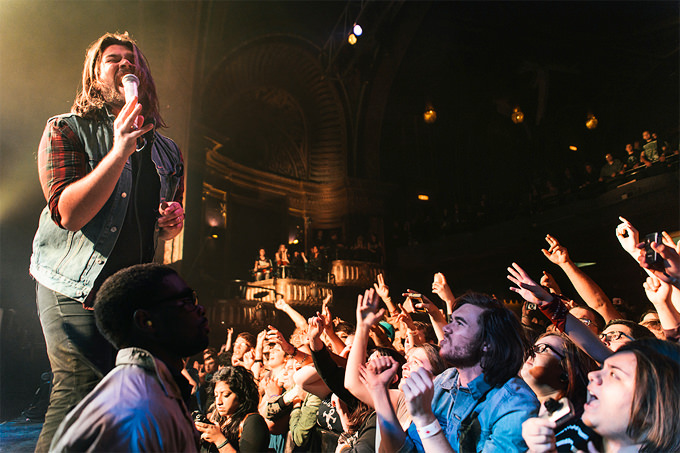
Taking Back Sunday at The Riviera Theatre – Watch out for crowd surfers
There are also a handful of venues that do not have a photo pit. This makes things interesting since you’re expected to provide stunning photos all while dodging the beer drinking, potentially moshing concert goers. Likewise in the pit, treat the concert goers with respect. They’ve paid good money to see the show. Just because you have a photo pass doesn’t mean you’re more important. Ask politely if you can occupy someone’s place for a moment. Most often they’ll let you. Arriving early makes it easier to get up front.
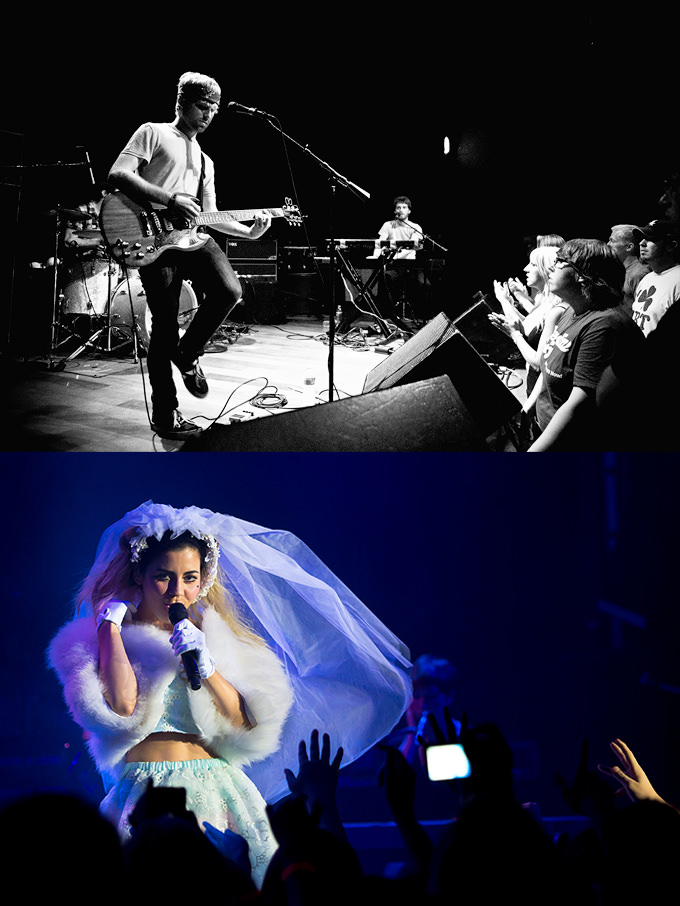
Jukebox the Ghost at Lincoln Hall, Marina & The Diamonds at Park West
If you’re shooting at a theater then you’ll likely be placed at either far stage-left or far stage-right. If that’s not bad enough these are usually the kinds of shows where the audience is sitting the whole time and sneering at you for every shutter actuation that occurs.
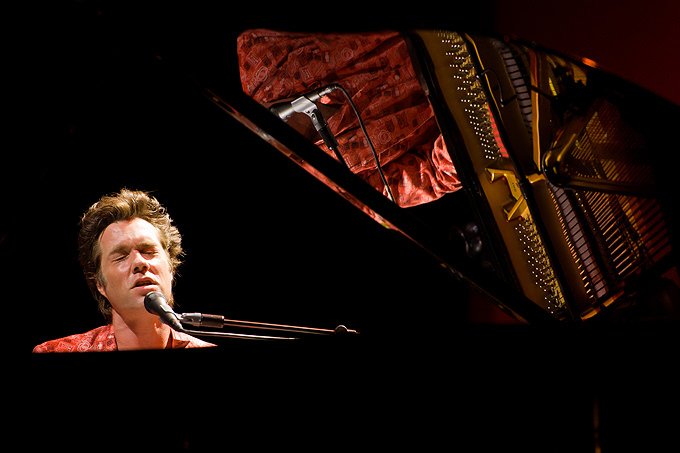
Rufus Wainwright at The Bank of America Theater – Shot from far stage-left
Another situation is the infamous soundboard shoot. After arriving at the venue you made it all the way to the front and got really excited when you saw that big pit. But then you saw the stainless steel containers and the security guard motioning you towards him. Little did you know that those containers were full of some gas to power the confetti cannon next to it.
You won’t be able to stand there and instead will have to try your luck from the soundboard. In most medium-sized venues you can get away with some decent shots. Unfortunately, everyone else is going to have the same angle and potentially even be using the same lens. In a larger venue you might wind up several hundred feet away from the stage. If you know this is going to be the case then you should look into renting a lens with a 300mm or greater focal depth.
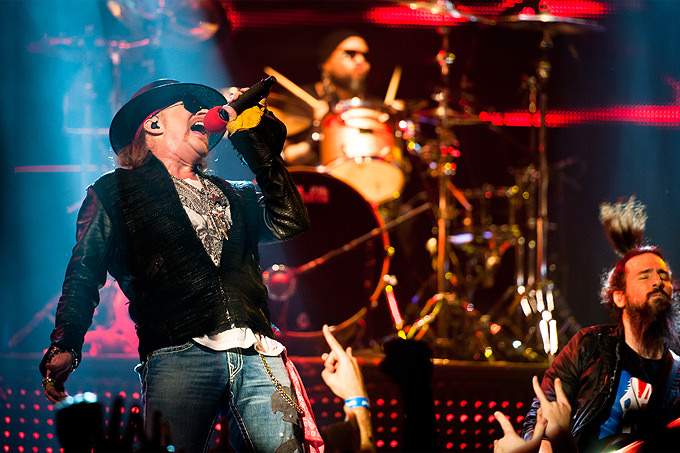
Guns N’ Roses at The House of Blues Chicago – Shot from the soundboard
How long will I be able to shoot for?
This answer is almost always the same no matter where you go: 3 songs. Yup, that’s it. You get approximately 15 minutes of unpredictable subjects and lighting to capture the golden moments of the show. This also means that you’re only going to have 3 songs to enjoy that view your friends think is so awesome. After your time is up you’ll be forced out of the pit and sent to return to the GA area with the rest of the concert goers.
If it’s a show that has assigned seats then you may need a separate ticket in addition to your media / photo credentials in order to enjoy the rest of the show. If you don’t have one then you may have to leave the venue after those 3 songs.
In some random cases a band will request that you only shoot the second and third songs or the first two. If you’re shooting at a venue without a pit then you might be able to shoot for the entire show. You might want to consider not doing this though. You run the risk of pissing off more of the fans if you’re getting in their way the whole time. I get it that you want to get “the shot” but being respectful is pretty high up on my personal bylaws. Another reason I don’t like to shoot the entire show because I don’t want to come home after and have hundreds more images to sort through and edit.
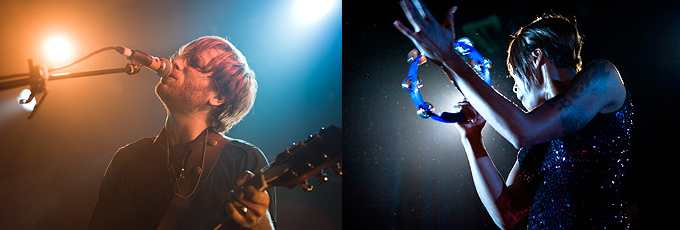
The Black Keys at Metro, Fitz & The Tantrums at Metro
Take heed to the 3-song rule if the venue specifies it. If the rule wasn’t made clear in the past and I decided to shoot around the venue after the first 3 songs there have been times where I’ve been approached by security and asked to stop shooting. If they are really upset I’ve seen security throw photographers out of venues or even worse, request to delete all the images on their memory card. It’s a bit harsh if you ask me but it’s still the rules.
What if I arrive and I’m not on the band’s list?
When you have many different people working together to put together the lists of those granted media / photo credentials, errors are bound to happen. Upon arriving at the venue it’s standard to visit will call to pick up your credentials. Don’t be surprised if once in awhile a tour manager forgets to turn in a list or your name has slipped off it. Keep that confirmation email handy.
Sometimes the will call attendant will be really nice and the email will be enough proof for them to grant you your credentials. If it’s not you should either contact the person who sent you the confirmation or if you’re lucky you might even have an onsite contact you can call. Hopefully you arrived early enough to make sure there wouldn’t be any problems since you’re only going to be allowed to shoot the first 3 songs.

Korn at The Congress Theater, Grace Potter & The Nocturnals at North Coast Music Fest
Come back next week to see Part 2 of this article covering the technical side of shooting a show including gear and settings.
All Images © Brendan Shanley












